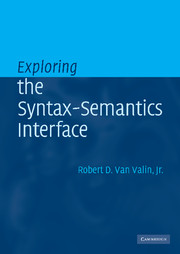Book contents
- Frontmatter
- Contents
- List of figures
- List of tables
- Preface
- List of abbreviations
- Introduction
- 1 Syntactic structure
- 2 Lexical representation and semantic roles
- 3 Information structure
- 4 Syntactic relations and case marking
- 5 Linking syntactic and semantic representations in simple sentences
- 6 The structure of complex sentences
- 7 Linking syntax and semantics in complex sentences
- References
- Languages index
- Subject index
6 - The structure of complex sentences
Published online by Cambridge University Press: 18 December 2009
- Frontmatter
- Contents
- List of figures
- List of tables
- Preface
- List of abbreviations
- Introduction
- 1 Syntactic structure
- 2 Lexical representation and semantic roles
- 3 Information structure
- 4 Syntactic relations and case marking
- 5 Linking syntactic and semantic representations in simple sentences
- 6 The structure of complex sentences
- 7 Linking syntax and semantics in complex sentences
- References
- Languages index
- Subject index
Summary
General considerations
The starting point for the discussion of the syntax–semantics–pragmatics interface in complex sentences is the syntactic structure of complex sentences. The units of the layered structure of the clause play a central role in the RRG theory of clause linkage, as they are the units which constitute the building blocks of complex sentences, and given RRG's approach to clause-internal relational structure, it is perhaps not surprising that the RRG theory of interclausal relational structure diverges from the standard analyses. Focus structure in complex sentences will also be discussed in this chapter, as well as the structure of complex NPs.
Nexus relations
Traditional, structural and generative grammar have all operated on the assumption that there are two linkage or ‘nexus’ types, coordination and subordination. Switch-reference constructions, particularly those in the languages of Papua-New Guinea as illustrated in (4.23), have long presented a vexing problem for theories of complex sentence structure. Coordination is characterized by the joining of two or more units of equal size and status, and, in the case of whole clauses, all of the clauses have the form of independent main clauses. Subordination, on the other hand, involves the embedding of one unit in another, and the embedded unit does not normally have the form of independent main clauses. The embedded clause functions either as an argument, as in complementation, or as a modifier, as in adverbial subordinate clauses. (Cf. Lyons 1968:178.)
- Type
- Chapter
- Information
- Exploring the Syntax-Semantics Interface , pp. 183 - 224Publisher: Cambridge University PressPrint publication year: 2005



